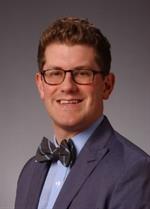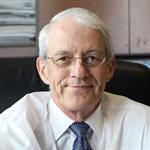 Charles Kenyon, DO
Charles Kenyon, DO
PGY-3 University of Washington
PHiT Board Member

Peter Esselman, MD, MPT, FAAPMR
Chair, Department of Rehabilitation Medicine
University of Washington
President, AAPM&R
Dr. Charles Kenyon, PHiT Board Member, chatted with Dr. Peter Esselman, AAPM&R President, about his physiatry career, participation with the Academy, and views on the specialty. Read on to discover Dr. Esselman’s unique background and perspectives.
What early influences led you to pursue a career in physiatry?
Dr. Esselman: My career arc in rehabilitation started early-on. Out of college, I worked as a physical therapy assistant in a skilled nursing facility. I went on to get a physical therapy degree from the University of Washington. During this time, I got to know our department chair, Dr. Justus Lehmann, and was also involved in research with Dr. Barbara de Lateur. After I finished my physical therapy degree, I got a job with the department as a research assistant. With these experiences I was exposed to rehabilitation medicine and it became my passion. And really, when I went to medical school, I was thinking about a career in physiatry. I was, and continue to be, excited about the long-term connection with patients. I also enjoyed the diversity of the field. I had the opportunity to explore many different areas of interest including neurorehab, brain injury, and spinal cord injury. I enjoy working with patients with trauma and disability to maximize their function while working with the interdisciplinary teams in our inpatient, hospital-based programs.
How have those early training experiences in physical therapy influenced your career?
Dr. Esselman: These experiences positively influenced both my clinical skills and perspective on the importance of working in multidisciplinary and interdisciplinary teams. Being trained as a physical therapist strengthened my understanding of the musculoskeletal system and anatomy at a much more in-depth level than was explored in medical school alone. Furthermore, these experiences helped me develop a deeper appreciation regarding the value of our physical therapy, occupational therapy, and speech language pathology colleagues in delivering effective team-based care to optimize patient outcomes.
Now as the chair of our department, my training as a both a physical therapist and a physiatrist has been invaluable as I am involved not only in managing our practicing physiatrists, but also the PM&R residency program, as well as our schools of physical therapy, occupational therapy, and prosthetics and orthotics. This puts me in a great position as the chair of the department that I understand what they are doing within each training program. Being able to integrate the interdisciplinary team from the early stages of training, including rehabilitation psychologists and vocational counselors amongst other invaluable members of the team, has helped strengthen our department.
Are there any lessons or advice that you picked-up during your residency training that have served you well throughout your career?
Dr. Esselman: When you reflect on residency you realize that you get to work with so many different attendings and faculty. It is an opportunity for you to see how other people work and develop your own style. I learned to form a connection with a patient from many tremendous mentors. I really try to get to know the patient as a person; what drives them, what motivates them? Every patient brings his or her own life experiences and expectations to this traumatic event that you are helping them through.
I think back on Dr. Justus Lehmann, our founding chair. He started the department of Rehabilitation Medicine at the University of Washington and was an early proponent of the interdisciplinary team. This is team-based care. As physiatrists, we are the leaders. But it’s team-based care and it’s back and forth with the therapy team and managing patient’s impairments to come up with the best treatment plan.
Please describe the role of the Board of Governors and the President within AAPM&R.
Dr. Esselman: All the physiatrists that work with the Academy are volunteers, and the Board of Governors is no different. They are a group of passionate, dedicated volunteers that have spent years working with and for the Academy. This group is responsible for leading the strategic direction, policies, and procedures of the Academy. With PM&R BOLD we have taken the step of really looking at the strategic vision for the specialty and we are trying to reach out beyond the Academy walls and envision, as a workforce, what our specialty will need over the next 5, 10, and 20 years and how we can continue to move the specialty forward.
As president of the Academy, I help to run the Board of Governors and set the strategic directions with both the Board of Governors and Academy staff. Over this year as president, I have also become a spokesperson for the specialty by representing our 9,000+ members; communicating with the membership and taking input to chart the future course for our specialty.
Tell us about your first volunteer experiences with the Academy. How have these experiences enriched your career beyond your clinical practice?
Dr. Esselman: I started volunteering for the Academy about 15 years ago. I was initially on the Health Policy and Legislation (HP&L) committee. What I love about the Academy is that all the committees work well. There is a structure around them. There is a staff person committed to facilitating the work of that committee. This is important because every physiatrist volunteer is also balancing their many other responsibilities. Therefore, the Academy staff plays a crucial role in executing our plans and strategic goals and I am constantly impressed with the expertise and skill of the Academy staff.
I joined HP&L and later chaired the committee for a few years, prior to serving as the chair for the Quality, Policy, Practice and Research (QPPR) committee that oversaw HP&L. As the QPPR chair, I was also on the Board of Governors and later transitioned into the presidential line as part of a four-year commitment to serve the roles of Vice President, President-Elect, Academy President, and Past-President.
How can residents and fellows engage with the Academy to advance the field of PM&R?
Dr. Esselman: For me, volunteering is very satisfying and extremely rewarding. Everything that I have done as a volunteer for the academy has informed me about what’s going on in PM&R and made me better at doing the job I’m doing as the chair of our department at University of Washington. For people that are really interested, you can learn so much by volunteering for the Academy. You get to know how the Academy works, you get to know how health care works in the United States, and the role of physiatry in the evolving health care market. I encourage everyone to volunteer for the Academy, it is a way to make a difference for the future of our specialty.
Last year the PHiT Council (formerly Resident Physician Council) celebrated 30 years of resident leadership within the Academy. How have you seen physiatry grow over the last 30 years?
Dr. Esselman: I think the biggest change has been the rise of our role in musculoskeletal medicine. Our department 30 years ago did not have anyone who was really specializing in musculoskeletal or sports medicine. We were very hospital-based, and very focused in neurorehab until about 15 years ago. We started to evolve and started to recruit scientists with expertise in sports and spine. Nationwide, I see that as an area that has continued to grow. We can help treat these patients appropriately and avoid long-term complications, and provide research-based non-surgical interventions, as well as appropriately refer patients to surgery when needed.
The other thing I have seen is the rise of research. 30 years ago, we were still very new to research as a field. This is rapidly changing in recent years with more and more physiatrists doing research and a center within the NIH to fund rehabilitation research.
Assistive technology has also changed tremendously. I have been at this long enough that I tell patients we thought it was cool when you could turn on the TV from across the room. And now we have gone so far beyond that to help patient’s access their world through advancement in prosthetics, mobility devices, and other assistive technologies.
The theme for Annual Assembly in 2019 is Uniting PM&R though Evidence & Best Practices. Why is this an important message for our field?
Dr. Esselman: It is vital for our field to continue to develop strong research and evidence regarding the value that we bring to the health care system with proven quality and cost-reductions. We need to strive for value-based care. I think we as physiatrists bring a lot of value to the health care system. We can manage complicated patients, get good outcomes, and do it cheaper. But we need to continue to pursue advancements in evidence-based practices in order to do this.
As residents we are often pulled in many different directions. Why is it important for physiatrists-in-training to be engaged in advocacy efforts for our specialty?
Dr. Esselman: It is important to be involved in advocacy. Medical school and residency are such a time of intense knowledge building. That is your focus – knowledge. But as you transition into a practice being aware and able to advocate for what you do is important. When people think about advocacy, they think about going to Capitol Hill and visiting with legislative aids and senators. This is very important work, and the Academy is taking an active role by having a staff member based in Washington D.C. as our advocacy expert to help guide our volunteer physiatrists through this process.
However, there is another aspect of advocacy that you need to consider. Where are you in your practice and how do you advocate for what you do and the value you bring to the health care system? Sometimes advocacy can be when you get in the elevator with the executive director of the hospital and you have 30 seconds to make your pitch for what you do and why physiatry is important. You must advocate right at that moment and convince them that what you do brings value to the health care system and what we do is important to them. That is one of the biggest parts of my job; to advocate for rehabilitation within our health care system. You don’t always have to think about advocacy as Capitol Hill visits, but you do need to advocate within your own system about the role of physiatry and patient-centered, team-based care.
How have you balanced leadership responsibilities with your family life and interests outside of medicine?
Dr. Esselman: As a leader of our department, I am very committed to my faculty maintaining a work-life balance. I really work to structure jobs and requirements so that I have time outside of work to spend with family and pursue additional interests. That is important to me.
I personally developed a skill a long time ago that when I leave work, I leave work at the hospital. It’s important to be able to remove yourself from the hospital at times and get into another environment, relax, and come back the next day to solve those problems and figure things out.
I spend a lot of time with family. I get outside, hike, garden, and look forward to vacations with family to maintain balance. I try not to get worked up about things. I had one of our burn surgeons ask me once, do you ever get mad? I said not really. I find that it’s not an effective way to manage. If you have the right perspective and keep the right team around, you can solve problems and keep patient care as a priority.
Thank you to Dr. Esselman for providing both his time and perspective!
